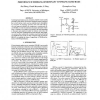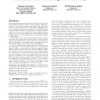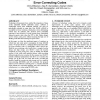27 search results - page 2 / 6 » DRAM reliability |
ISCAS
2003
IEEE
13 years 11 months ago
2003
IEEE
Tunneling based random-access memories (TRAM’s) have recently garnered a great amount of interests among the memory designers due to their intrinsic merits such as reduced power...
CACM
2010
13 years 6 months ago
2010
Memory scaling is in jeopardy as charge storage and sensing mechanisms become less reliable for prevalent memory technologies, such as dynamic random access memory (DRAM). In cont...
SIGMETRICS
2009
ACM
14 years 23 days ago
2009
ACM
Errors in dynamic random access memory (DRAM) are a common form of hardware failure in modern compute clusters. Failures are costly both in terms of hardware replacement costs and...
ISCA
2010
IEEE
13 years 10 months ago
2010
IEEE
Technology advancements have enabled the integration of large on-die embedded DRAM (eDRAM) caches. eDRAM is significantly denser than traditional SRAMs, but must be periodically r...
ISCA
2010
IEEE
13 years 11 months ago
2010
IEEE
DRAM vendors have traditionally optimized the cost-perbit metric, often making design decisions that incur energy penalties. A prime example is the overfetch feature in DRAM, wher...



